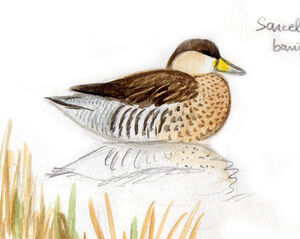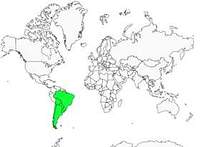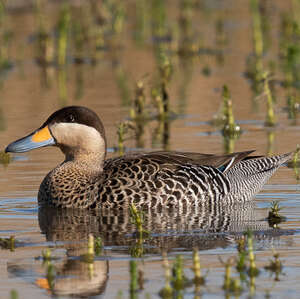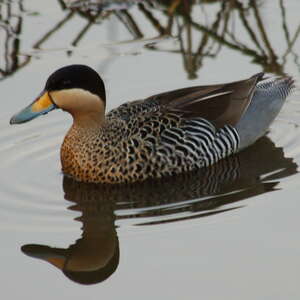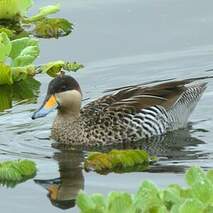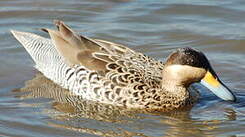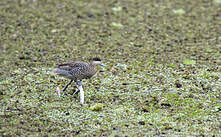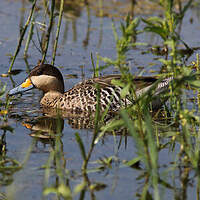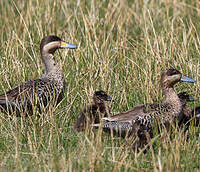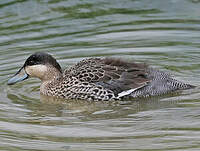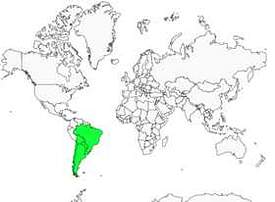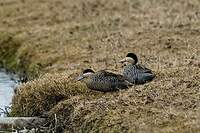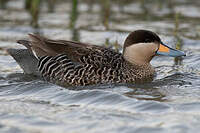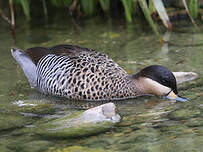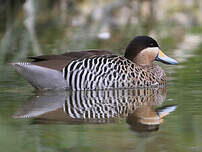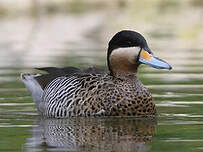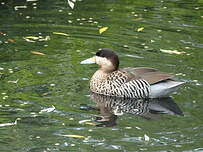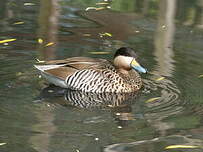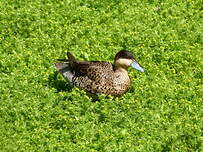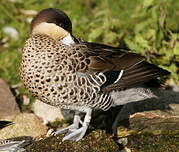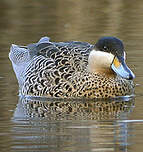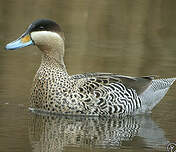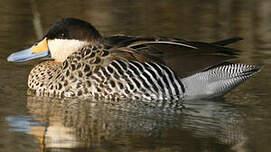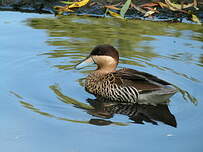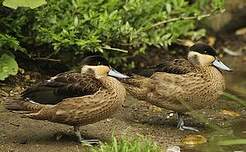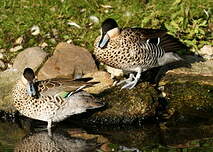Silver Teal
Spatula versicolor - Sarcelle bariolée
Identification
The Silver Teal has a light blue beak with a yellow area at the base of the upper mandible and a black median stripe. Its blackish cap, which extends to below the eyes, contrasts with the very light (yellowish-white) sides of the head and neck. The feathers of the mantle and the scapulars are black with a whitish edge, those of the back are white with black transverse lines. The chest, flanks and bend of the wing are of an ocher color with black spots. The abdomen is greyish with fine black transverse lines. The primary remiges are of a dark brown and the mirror is of a bright green with a white bar in front and behind. The feet are grey.
Quite small in size (36-41cm), this teal shows a very little sex dimorphism. The female's plumage is duller than the male's. She has shorter tertiaries and less yellow at the base of the beak. The juvenile is still duller than the female with a brown cap and short tertiaries. The Puna Teal has formerly been considered as a subspecies of this bird. Currently, two subspecies are distinguished: A. versicolor versicolor that can be found in Paraguay, southern Bolivia and southern Brazil; A. versicolor fretensis which lives in southern Chile, Argentina and the Falkland Islands. It is distinguished by the patch at the base of the beak which is larger and of a yellow/orange color.
Subspecific information 2 subspecies
- Spatula versicolor versicolor (c Chile to s Brazil and s Argentina)
- Spatula versicolor fretensis (s Chile and s Argentina, Falkland Is.)
Foreign names
- Sarcelle bariolée,
- Cerceta capuchina,
- marrequinha-multicolor,
- Silberente,
- ezüstréce,
- Zilvertaling,
- Alzavola argentata,
- silverand,
- Sølvand,
- kačica striebristá,
- čírka modrozobá,
- Pampasand,
- kalottitavi,
- xarxet encaputxat,
- srebrzanka modrodzioba,
- Разноцветный чирок,
- ギンイロシマアジ,
- 银鸭,
- 銀鴨,
Voice song and call
Behaviour character trait
Dietfeeding habits
Reproduction nesting
The Silver Teal reaches sexual maturity at one year. The breeding season is quite variable. It runs from October to November in the southern regions but can extend from September to March in Peru.
It is the female that builds the nest and incubates. The nest is built with grass. It is well hidden in dense and high vegetation near water. The female lays 6 to 10 eggs that are white-cream or pale pink in color (size: 58 x 44 mm, weight: 34 g). The incubation period lasts 25 to 27 days. From an early age, the chicks look for their own food under the protection of both parents. The young acquire their full plumage after 50 to 60 days.Geographic range
Threats - protection
IUCN conservation status
concern
in the Wild
threatened
evaluated
The Silver Teal has a large distribution area, its population is numerous and its numbers are stable. The species is not vulnerable but the reduction of its habitats can be detrimental to it.
Sources of information
- IOC World Bird List (v14.2), Gill, F and D Donsker (Eds). 2024-04-18.
- Wikipédia, Wikipedia, The Free Encyclopedia
- Avibase, Lepage Denis
Other sources of interest
 Specification sheet created on
03/08/2023 by Jean-Pierre Trouillas
Specification sheet created on
03/08/2023 by Jean-Pierre TrouillasTranslation by AI Oiseaux.net
© 1996-2025 Oiseaux.net
- Accipitriformes
- Aegotheliformes
- Anseriformes
- Apodiformes
- Apterygiformes
- Bucerotiformes
- Caprimulgiformes
- Cariamiformes
- Casuariiformes
- Charadriiformes
- Ciconiiformes
- Coliiformes
- Columbiformes
- Coraciiformes
- Cuculiformes
- Eurypygiformes
- Falconiformes
- Galliformes
- Gaviiformes
- Gruiformes
- Leptosomiformes
- Mesitornithiformes
- Musophagiformes
- Nyctibiiformes
- Opisthocomiformes
- Otidiformes
- Passeriformes
- Pelecaniformes
- Phaethontiformes
- Phoenicopteriformes
- Piciformes
- Podargiformes
- Podicipediformes
- Procellariiformes
- Psittaciformes
- Pterocliformes
- Rheiformes
- Sphenisciformes
- Steatornithiformes
- Strigiformes
- Struthioniformes
- Suliformes
- Tinamiformes
- Trogoniformes

